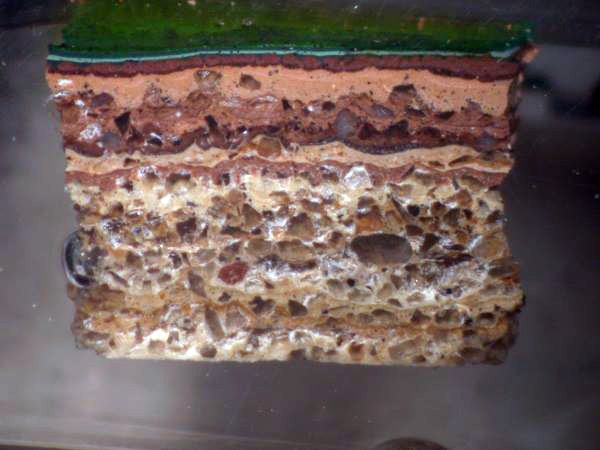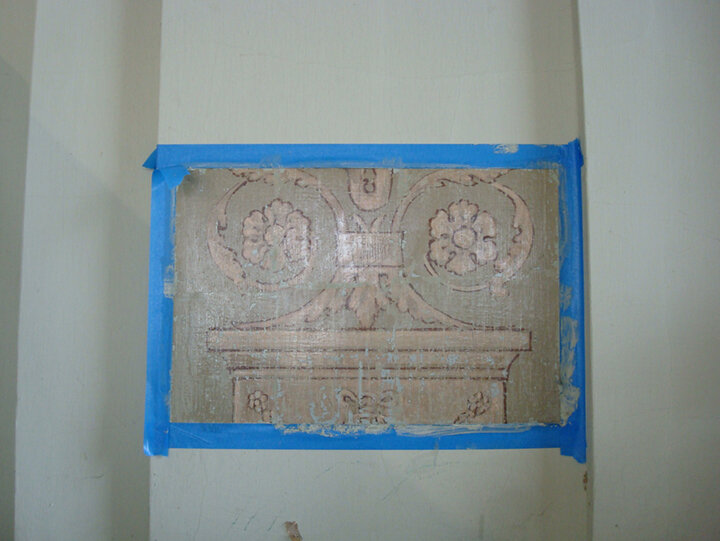
Paint Analysis
Architectural paint analysis, also known as finishes investigations or paint archaeology, is used to identify paint colors and decorative finish schemes and how they have changed over time. Members of our staff are experts in architectural paint analysis and paint color investigations, and have authored books and scholarly articles on the subject, as well as given presentations internationally.
A variety of techniques are used depending on the goals of a project and the suspected types of finishes. These techniques include archival research, on-site investigations (exposure panels), microscopy, instrumental analysis, and experimentation.
Archival research can be an invaluable tool in understanding a particular finish and how it may have changed. We utilize old photographs, first person accounts, specifications, and our extensive library of period trade publications to establish the context for a finish investigation.
On-site investigations are a critical step in any paint research project. Our experienced conservators will visit your site to evaluate the condition of finishes and identify areas to extract samples for microscopic analysis or exposure panels.
Microscopy is used to identify the chromochronology (i.e. change in the colors of paint layers over time), types of paint, and other characteristics of finishes. Our conservators visit your site and remove small samples from locations that are carefully selected to yield the best information. We mount and polish each sample in our laboratory to provide a clear cross section. A microscope fitted with specialized daylight and UV light sources is used to carefully document each finish layer. Finishes are matched to the universal Munsell Color System and a commercial paint manufacturer’s color deck, with samples of finish colors provided in a written report. Experience and a trained eye are crucial to accurately identifying finishes as certain pigments may fade and binders may yellow over time.
Some paint analysis projects require a higher level of understanding. We utilize microscopic particle analysis and advanced instrumental techniques such as Fourier-transform infrared spectroscopy (FTIR), and gas chromatography–mass spectrometry (GC-MS) to identify specific pigments and binders. For glazes, stenciling, faux finishes and other elaborate decorative schemes, our conservators use decorative finishing techniques to prepare mockups and sample boards to help our clients visualize their original appearance and inform restoration efforts.
Where more elaborate decorative finishes, such as stenciling or faux wood graining are suspected, we perform on-site exposure panels or “reveals” to very carefully strip away contemporary finishes and expose earlier finishes. Reveals require an expert understanding of paint chemistry and the types of solvents that will affect different types of coatings and should only be performed by trained conservators.
Staff Paint Publications
M. Jablonski, co-editor, Examining the Built World Through Architectural Finishes, London: Archetype Publications, Ltd, 2024.
M. Jablonski, co-editor, Macro to Micro: Examining Architectural Finishes, London: Archetype Publications, 2018.
M. Jablonski, “Alabastine: using trade catalogues, patents and advertisements to find a company” in Architectural Paint Research: Sharing Information, Sharing Decisions, London: Archetype Publications, 2014: 11-22.
M. Jablonski, editor, Architectural Finishes in the Built Environment, London: Archetype Publications, 2009.
M. Jablonski, “Do You See what I See: Historic Paint Colour Investigations,” in Paint Research in Building Conservation, London: Archetype Publications, 2006: 45-51.
S. Hoagland, “The Tasteful Tenement: Forgotten Finishes at the Lower East Side Tenement Museum” in
Macro to Micro: Examining Architectural Finishes, London: Archetype Publications, 2018: 111-118.
S. Hoagland, "From Pauper to Prince: Re-interpreting St. John's Colonial Building through Decorative Finishes" in
Standards in Architectural Paint Research, London: Archetype Publications, 2014: 145-52.
S. Hoagland, “The Tasteful Tenement: Forgotten Finishes at the Lower East Side Tenement Museum” in Macro to Micro: Examining Architectural Finishes, London: Archetype Publications, 2018: 111-118.
H. Thomas-Haney and X. Flandro, "A Survey of Historic Finishes for Architectural Aluminum, 1920-1960" in
The Association of Preservation Technology Bulletin No.1 2015.
J. Kearney, "Color and Design for the Masses: Corbusier and Consumerism in Commercial Catalogs" in Architectural Finishes in the Built Environment. London: Archetype Publications, 2009.
Paint sample from Lower East Side Tenement Museum showing the effects of heat from a fire.
Multiple layers of sanded paint from a private home in Brooklyn.
An unusually rich paint sample, mounted, sectioned, and polished for analysis.
An interesting paint sample with air voids from the Lower East Side Tenement Museum.
A conservator examines paint samples using a polarizing light microscope.
Exposure panel showing elaborate decorative painting behind monotone modern paint scheme.
Polished cross-section demonstrating the complexity of interpreting some samples.
Exposure panels compared to photomicrographs of polished samples, showing polychromatic color scheme.
A conservator removes a paint sample using a scalpel.
A conservator selectively strips away modern finishes for an historic finishes exposure panel.
Conservators performing an exposure panel to uncover faux wood graining.
Paint sample from Harmony Hall in Maryland showing how colorful spaces end up being painted white and monotone over time.













